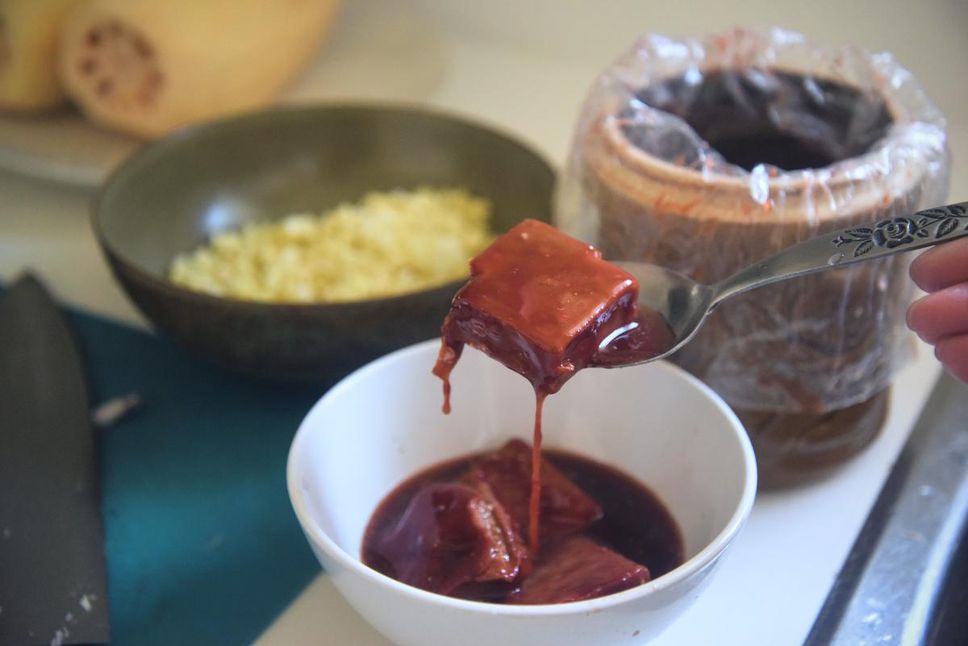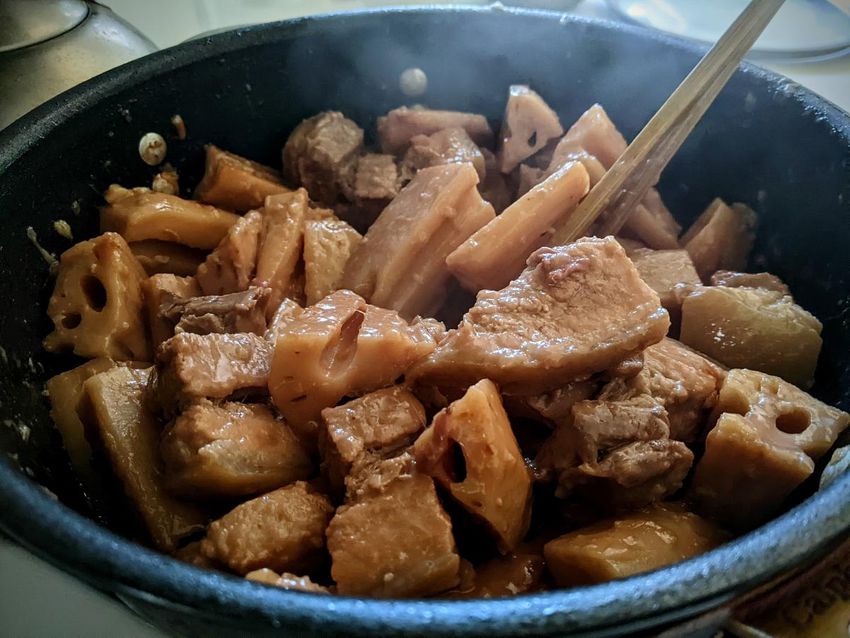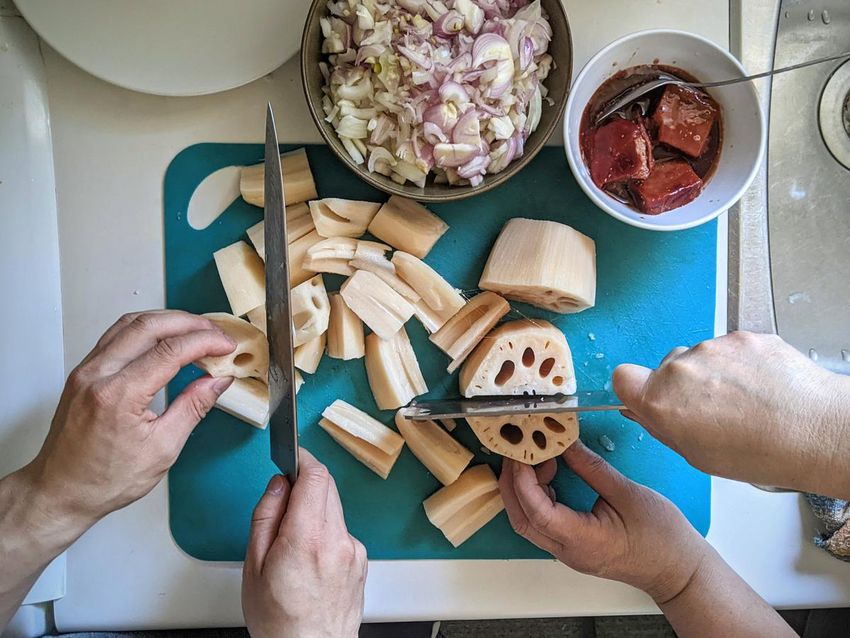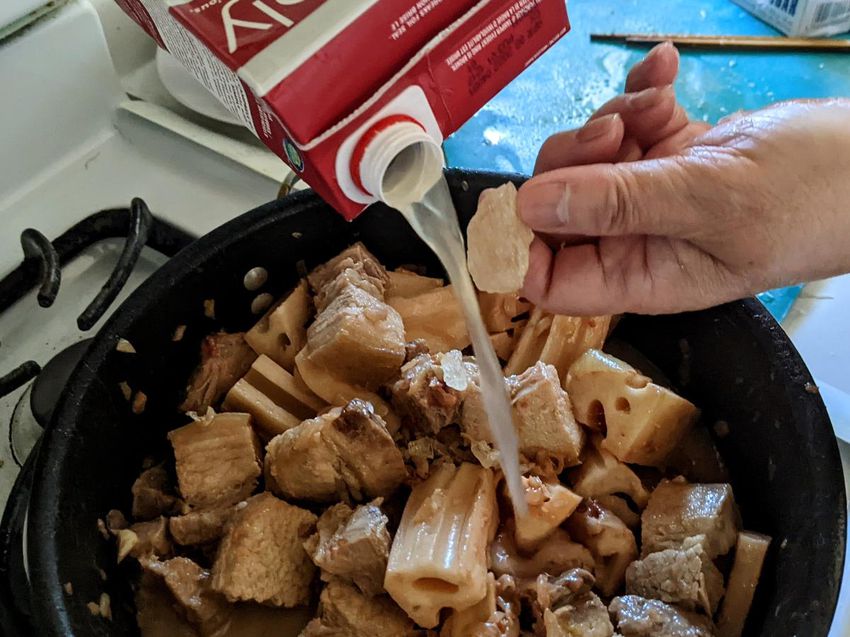It’s the third time my mom’s overseeing my attempt at making some iteration of Grandma’s braised pork belly and lotus root.
First and second generation immigrant kids can probably guess what the initial process of getting the recipe from mom was like. It’s become a trope at this point, repeated in cookbooks written by chefs replicating family recipes. I’ve even made mention in articles I’ve written from time to time.
Mom doesn’t use measuring cups or spoons. And if she does, the spoon she uses to measure is the same one I use to eat ice cream. Larger things are measured in handfuls or that one metal bowl. Nothing is timed. Her philosophy of her: you know when it’s done when you taste it.
It’s a frustrating time.
I’m frustrated at the lack of straightforward steps. She’s frustrated because asking her how many tablespoons she used is equivalent to asking her to break down the molecular structure of soy sauce.
Somehow we make it through.
When it comes to learning how my mom cooks I’ve decided to ditch the notes. The only way to truly understand her method is to simply have her next to me and to do it through repetition.
“Write as much as you need, but you have to pay attention to what I’m doing,” mom said.
Grandma passed away almost 25 years ago and, of course, she never wrote down any recipe, including this dish with a fermented bean curd sauce so good, as a child I’d polish off three bowls of rice every time.
The dish has everything: Jiggly pieces of skin-on pork belly that’s been simmered to a point where the meat tears off in fine silky threads.
Tender hunks of lotus root that still retain a hint of watery crunch.
All of that simmered for an hour in a sauce made from nam yue, a red fermented bean curd packed with so much umami it makes Parmesan taste like a rice cake.
It’s tempered with little irregular lumps of dissolved rock sugar (less sweet than the granulated kind) and added to a base of fried garlic and shallots (or onions, this time around, as the supermarket’s shallots weren’t up to par).
It’s a Cantonese dish not often seen in the city’s restaurants, but a stir-fry version of it exists (no. 19) on the lunch special menu at Ming’s Noodle Cafe in Scarborough (3447 Kennedy Rd.).
The first time mom showed me how to make it, I made this big production of taking everything she chopped and poured and transferring it into a bowl and then a measuring cup or spoon. I wrote down the time it took to fry the pork belly, as well as the aromatics. It was like I was going to have it published (not today, sorry, reader).
I remember furiously writing to keep up with her, but when I wrote “sauté” I missed that she uses wooden chopsticks rather than a spatula because it does a better job of breaking up the clumps of bean curd and rock sugar to make the sauce.
The shade of light brown I wrote to watch out for when frying the pork belly skin was never the same in reality.
I ended up asking mom what she thought I meant when I wrote “add more broth” in one of the steps.
“I thought this was supposed to make the process easier,” she said. “Just watch what I do next time.”
I’ve since learned that even the most detailed notes cannot replace the tastes, smells, sights, feels and even the sounds of the process picked up each time watching mom cook.
Listening to mom suck her teeth or having her push me aside to take over whatever task I’m doing wrong is more effective than any recipe footnote.
Of course, written recipes are important when learning to cook. They’re also essential in maintaining consistency at a restaurant or food company, and I sure as heck don’t trust myself to bake anything by just eyeing the amounts.
But when it comes to learning how to cook like my mom and capturing the spirit of the dish, I’ve come to the realization that I need to do it on her terms. More importantly, I need to get over the idea that the recipe doesn’t conform to the standards I’m used to, but she isn’t. For one thing, back in Grandma’s time, ingredients were measured by taels and cats, not ounces and milligrams.
If mom’s using the ice cream spoon to measure, I will do the same.
There’s still a method and technique perfected over time and, yes, using a rice bowl to measure chicken stock is still measuring. It’s just not in the way I was conditioned to believe is the right and only way, and cooking alongside her made me snap out of it.
Being able to replicate the flavors is one way of making sure my family’s cooking lives on for another generation, but I’ve realized replicating the quirks and nuances of the process are also part of that.
Sure, standardizing her recipes to modern format is useful (for whom, I have no idea because I am not writing a cookbook), but if I replace her rice bowls with measuring cups and the chopsticks with a spatula, I will lose a part of her in the process.
I’m already learning how to pick the ideal lotus root (heavy for its size, and no blemishes or black spots) and the brand of red fermented bean curd paste mom prefers (the Double Happiness brand that comes in a brown clay jar).
I might as well respect the whole process and do everything the way she does it, rather than trying to force methods and measurements that didn’t exist for her to begin with.
“And then you’ll blame me when it doesn’t taste good because you messed up the conversions,” mom said, laughing.
Not every cherished recipe has to be written down for it to live on. Spending time in the kitchen with mom, petty quips and all, until I get the dish right is worth it for me. Even if my memory will not last as long as a notebook, the time spent with her in the kitchen makes the food taste better than any recipe I could ever have written out.
JOIN THE CONVERSATION




